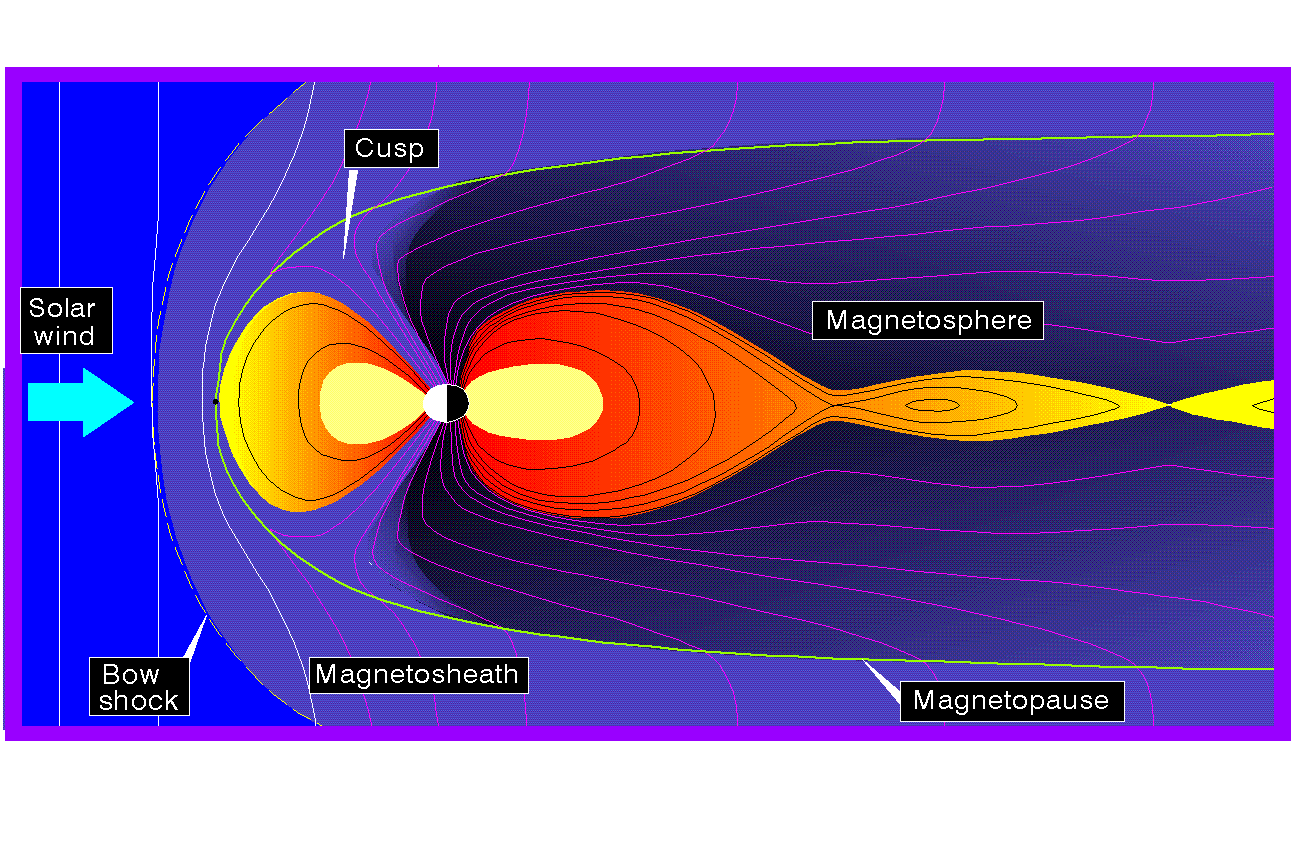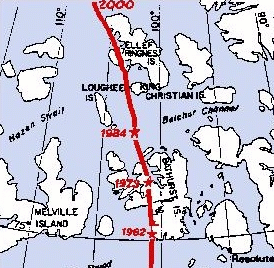

| Welcome to the IMAGE satellite tutorial on Earth's magnetic field. This page contains a brief introduction to magnetism, and Earth's field. It also provides links to additional IMAGE reading materials, and a collection of classroom activities that help students understand Earth's manetic field and its changes through time and space. | An Introduction to Geomagnetism |
|
A compass tells you what direction is 'North', but have you ever wondered how it can do that? The answer has to do with something called magnetism. Every magnet produces an invisible area of influence around itself. When things made of metal or other magnets come close to this region of space, they feel a pull or a push from the magnet. Scientists call these invisible influences FIELDS. You can make magnetic fields visible to the eye by using iron chips sprinkled on a piece of paper with a magnet underneith. |  |
|
On the Sun, our nearest star, you can see the same kinds of magnetic fields as they pop out of the surface of the sun. This picture shows the lines of magnetism near a sunspot. The entire planet Earth would easily fit under the archway formed by the magnetic field loop. We can see these loops of magnetism on the sun because very hot gases flow along them and light them up! |  |
|
A compass works the way it does because Earth has a magnetic field that looks a lot like the one in a magnet. The Earth's field is completely invisible, but it can be felt by a compass needle on the Earth's surface, and it reaches thousands of miles out into space. If you were to study the Earth's invisible magnetic field from space, it wouldn't really look like a bar magnet at all. Earth's magnetic field gets stretched out into a comet-like shape with a tail of magnetism that stretches millions of miles behind Earth, opposite from the sun. The sun has a wind of gas that pushes Earth's field from the right to the left in the drawing below. Scientists have studied many different parts of Earth's magnetic field and have given them names so that they can talk to one another about them. Each part is part of the vast 'geomagnetic system' in which many amazing things have been seen and discovered. | |
 | |
|
In your classroom, you can make a magnetic field by letting a current flow through a piece of wire wrapped around a nail. When you attach the battery, the nail becomes an ELECTROMAGNET and you can use it to lift paperclips. Here is a simple activity that lets you experience electromagnetism for yourself. It's important to do this experiment A Simple Electromagnet at least once in your life so that you can better appreciate how electromagnets and magnetism work. |  |
| The core of Earth is also an electromagnet. Although the crust is solid, the core of the Earth is surrounded by a mixture of molten iron and nickle. The magnetic field of Earth is caused by currents of electricity that flow in the molten core. These currents are hundreds of miles wide and flow at thousands of miles per hour as the earth rotates. The powerful magnetic field passes out through the core of the earth, passes through the crust and enters space. This picture was created by a computer from a mathematical model, shows the solid inner core region (inner circle) surrounded by a molten outer core (the area between the two circles). The currents flow in the outer core, and the lines of force shown in yellow, travel outwards through the rest of Earth's interior. If the earth rotated faster, it would have a |  |
| stronger magnetic field. If it had a larger liquid core it would also have a stronger magnetic field. By the time the field has reached the surface of earth, it has weakened a lot, but it is still strong enough to keep your compass needles pointed towards one of its poles. | |
|
The magnetic poles of Earth are not fixed on the surface, but wander quite a bit as the map shows. The pole in the Northern Hemisphere seems to be moving northwards in geographic latitude by about 10 kilometers per year, but the motion is only an averge. On any given day, it moves erratically by many tens of meters because of changes in the currents inside Earth's core, as well as the influence of electrical currents in the ionosphere, and the changing space environment due to solar storms and winds. If you were to stand directly over the magnetic pole with a compass, the needle would point straight downward. At other points on the globe, it points horizontally, but if you could observe it carefully, you would also see a slight dip in the needles tip. As you approach the magnetic pole, this dip becomes more and more obvious. |  |
|
Studies of the Mid-Atlantic Ridge in the Atlantic Ocean half-way between North America and Europe have shown that as the fresh rock cools, it records the polarity of Earth's field. By dating the rocks on either side of the ridge, geologists discovered that the polarity of the Earth's field changes over the course of thousands of years. This was an exciting discoverery that not only verified the theory of Continental Drift, but demonstrated that Earth's magnetism isn't constant over millions of years. The magnetic field of Earth actually changes its polarity over time. They are called Polarity Reversals, but should not be confused with the rotation axis of Earth actually changing. | |
 | |
|
The last one of these Polarity Reversals happened about 770,000 years ago (770 on the above graph). We are currently living during a period that has been called the Brunhes Magnetic Chron when the South Magnetic Pole is in the Northern Hemisphere. During the previous Matumaya Magnetic Chron, the North Magnetic Pole was in the Northern Hemisphere! At the prresent time, Earth's magnetic field is weakening in strength by 5% every 100 years. It may be near zero in another few thousand years at this rate. The figure above, however, shows that Earth's field often changes its strength significantly in a short time (measured in thousands of years) and often does not vanish everytime. Scientists have a lot to learn about the exact behavior of Earth's complex field. Until then, making predictions about what it may look like in a few thousands years from now is a matter of guessing, not forecasting. | |
|
Additional Reading and Resources
| |
|
Classroom Activities | |
|
The IMAGE satellite program has supported teachers to create a wide range of classroom activities through its summer intern program at the NASA, Goddard Space Flight Center. Most of them are in PDF format and require an Adobe Acrobat reader. | |
| Basic properties of magnetic fields |
Playing With Magnetism - Grades K-5
Introduces the student to simple toy magnets to explore magnetic attraction using paper clips.
They will examine how its invisible field can affect matter.
The students will demonstrate the attracting and repelling properties of magnets.
Exploring Magnetic Fields - Grades K-5
Students investigate the presence of magnetic fields around magnets, the sun and the earth.
The students will explore that a magnetic force is an invisible force.
Students investigate a magnet's attracting and repelling properties.
Electricity and Magnetism - Grades 3-9
Introduces the student to electromagnetism.
Student constructs an electromagnet and uses it to study currents and magnetism.
The Inverse-Cube Law for
Magnetism - Grades 9-12
Students will use a Soda Bottle Magnetometer to study how the force of magnetism changes with distance.
Gravity follows an 'inverse-square' law.
Students will discover that magnetism follows an 'inverse-cube' law of decrease with distance.
Exploring the Earth as a
Magnet - Grades K-5
Introduces the student to Earth's protective region, called the magnetosphere.
The students will gain an understanding of how the earth's magnetosphere interacts with the charged plasma sent from the sun via the solar wind and CME's.
|
| Earth's Changing Magnetic Field |
The Wandering Magnetic Pole: Introduction - Grades 9-12 Students will plot the location of Earth's north magnetic pole on a polar 'longitude-latitude' plot. This is the Introductory teacher material for the related activities on Earth's magnetic pole. Wandering Poles in the Last 2000 Years - Grades K-5 The students will gain an understanding of why the surface of the Sun is so active. The students will explore how magnetism on the Sun causes gases to move. Plotting Points in Polar Coordinates - Grades 10-12 Students will plot points on a polar grid and measure distances between them. Measuring Distances on a Polar Map- Grades 10-12 Students will plot points on a polar grid and measure distances between them. The Magnetosphere and Us- Grades 6-9 Students explore the size of the magnetosphere and how long it takes various forms of particles and radiation to reach Earth from the sun. A Soda Bottle Magnetometer - Students will build and operate a simple magnetometer using a soda bottle and a bar magnet. They will use it to monitor changes in Earth's magnetic field. They will study magnetic storms and investigate their properties in time and space. They will make measurements and perform simple statistical analysis. Magnetic Storms from the Ground - Grades 6-9 Students will use web-based archival data to study the geographic variations in a specific magnetic storm event. Students will compare the geographic location against locations where aurora are commonly observed. Investigating Magnetic Storms - Grades 9-12 Students will learn about the Kp index for measuring magnetic storm severity. Students will use a web-based archive to investigate how frequent magnetic storms are for various degrees of severity. Motion of the Magnetic Pole - Grades 6-9 Students will plot on a map the latitude and the longitude involved in the movement of the Magnetic North Pole over a period of time. They will predict the location for the year 2000 and justify their reasoning. Students will use a formula to calculate the speed (an example is given). Students will conclude that the Magnetic North Pole moves year to year. Investigating Earth's Magnetism - Grades 9-12 Students will explore the shape of Earth's magnetosphere and how it changes during a storm event. The Magnetopause Boundary - Grades 10-12 Simple algebra is used to calculate the distance to the boundary where the solar wind presses on Earth's magnetosphere. This activity discusses pressure balance and mathematical descriptions of the forces involved. The Magnetopause Boundary - Grades 10-12 Simple algebra is used to calculate the distance to the boundary where the solar wind presses on Earth's magnetosphere. This activity discusses pressure balance and mathematical descriptions of the forces involved. Magnetic Storms and Solar Activity - Grades 6-9 Students will use two web-based data archives to explore how solar activity is correlated with magnetic storms on Earth. Magnetic Storms and Aurora - Grades 9-12 Students will use web-based archives to explore the correlation between auroral activity and the Kp magnetic index. Auroral Magnetism from the Ground - Grades 7-9. During the last 100 years, many 'magnetic observatories' have been commissioned around the world to monitor Earth's magnetic field. By analyzing graphical data, students will become familiar with Earth's changing magnetic field through solar storm activity plots. Long-Term Magnetic Variations - Grades 7-9. Students use tabulated data to create a graph of Earth's magnetic intensity. They forecast when, or if, our current field will actually fall to zero-strength in the future. Magnetic Reversals: Fact and Fiction. - Grades 7-9. Students compare two science fiction stories and a scientific appraisal about what might happen when the next magnetic reversal happens. They critically evaluate fictional claims to identify factual errors. |
